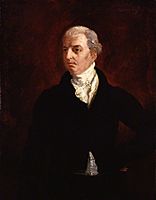Liverpool ministry facts for kids
Quick facts for kids Liverpool ministry |
|
|---|---|
 |
|
| 1812–1827 | |

Liverpool (1823)
|
|
| Date formed | 8 June 1812 |
| Date dissolved | 9 April 1827 |
| People and organisations | |
| Monarch |
|
| Represented by | Prince Regent (1812–1820) |
| Prime Minister | Lord Liverpool |
| Member party | Tory Party |
| Status in legislature | Majority |
| Opposition party | Whig Party |
| Opposition leaders |
|
| History | |
| Election(s) |
|
| Legislature term(s) |
|
| Predecessor | Perceval ministry |
| Successor | Canning ministry |
This article is about the British government led by Lord Liverpool. He was the Prime Minister of the United Kingdom from 1812 to 1827. Lord Liverpool was chosen by the Prince Regent (who later became King George IV). This happened after the previous Prime Minister, Spencer Perceval, was sadly killed.
Contents
Lord Liverpool's Government (1812-1827)
Lord Liverpool's time as Prime Minister was one of the longest in British history. His government faced many challenges, including the end of the Napoleonic Wars and changes in society. They worked to keep Britain stable during a time of big changes.
What Was the Cabinet?
The Cabinet is a group of the most important ministers in the government. These ministers lead different departments and help the Prime Minister make big decisions for the country. They meet regularly to discuss important issues.
Key Cabinet Members and Their Jobs
From 1812 to 1827, Lord Liverpool's Cabinet included several powerful figures. Each person had a key role in running the country. Here are some of the main members:
- Lord Liverpool – He was the First Lord of the Treasury. This is like being in charge of the country's money and overall government. He was also the Leader of the House of Lords, guiding discussions in that part of Parliament.
- Lord Eldon – The Lord Chancellor. This is the most senior judge in the country and a key legal advisor to the government.
- Lord Harrowby – The Lord President of the Council. This role involves advising the King and overseeing certain government bodies.
- Lord Westmorland – The Lord Privy Seal. This minister holds one of the oldest offices in government, with duties that varied over time.
- Lord Sidmouth – The Secretary of State for the Home Department. He was in charge of internal affairs, like law and order within Britain.
- Lord Castlereagh (later Lord Londonderry) – The Secretary of State for Foreign Affairs. He handled Britain's relationships with other countries. He was also the Leader of the House of Commons.
- Lord Bathurst – The Secretary of State for War and the Colonies. He managed the military and Britain's overseas territories.
- Lord Melville – The First Lord of the Admiralty. He was in charge of the Royal Navy.
- Nicholas Vansittart – The Chancellor of the Exchequer. This is the minister responsible for the country's finances and budget.
- Lord Mulgrave – The Master-General of the Ordnance. He oversaw military supplies and artillery.
- Lord Buckinghamshire – The President of the Board of Control. This role managed affairs related to British India.
- Charles Bathurst – The Chancellor of the Duchy of Lancaster. This was a role with varied duties, often involving managing royal lands.
- Lord Camden – A minister without portfolio. This means he was a minister in the Cabinet but didn't have a specific department to run.
Important Changes Over Time
The Cabinet didn't stay exactly the same throughout Lord Liverpool's long time in office. Some ministers left, and new ones joined. Here are some of the notable changes:
- Late 1812: Lord Camden, the minister without portfolio, left the Cabinet.
- September 1814: William Wellesley-Pole joined the Cabinet. He was the Master of the Mint, in charge of making coins.
- February 1816: George Canning took over from Lord Buckinghamshire as President of the Board of Control.
- January 1818: Frederick John Robinson joined as the President of the Board of Trade. This role focused on trade and business.
- January 1819: The famous general, the Duke of Wellington, became Master-General of the Ordnance. Lord Mulgrave, who held that role before, became a minister without portfolio.
- 1820: Lord Mulgrave left the Cabinet completely.
- January 1821: Charles Bathurst became President of the Board of Control, taking over from Canning. He also kept his role at the Duchy of Lancaster.
- January 1822: Robert Peel became the new Home Secretary, replacing Lord Sidmouth.
- February 1822: Charles Williams-Wynn took over as President of the Board of Control. Charles Bathurst remained in the Cabinet.
- January 1823: Nicholas Vansittart, now known as Lord Bexley, became Chancellor of the Duchy of Lancaster. F.J. Robinson became Chancellor of the Exchequer. William Huskisson then took over as President of the Board of Trade.
- 1823: Lord Maryborough, the Master of the Mint, left the Cabinet. His replacement was not a Cabinet member.

